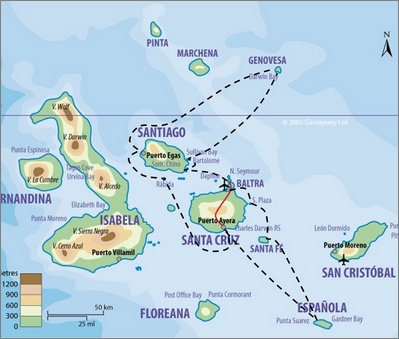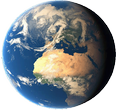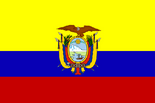





| This island was, if you ask us, one of the least interesting, at least on land. Little special to see and very hot. But snorkeling, what absolutely fabulous. We were accompanied by a couple of agile sealions playing around us and we saw a staggering 20 or so sea turtles in 30 minutes of snorkeling. So that was great. |

| South Plazas is a little island just off the coast of Santa Cruz. Due to itssmall size it's supposedly the oinly place where the marine and land Iguanahave been docmuneted to interbreed, giving rise to land-dwelling intermediates. The island has beautiful opuntia cactuses and nice cliffs where you can find blue-footed boobies, tropicbirds and shearwaters. |
| Bartolome is mainly interesting for its snorkeling, with potentially penguins, and for its splendid panorama view after climbing one of its hills. Along the way up to the top, there are some interesting plants to see, such as the pioneerplants, the lava cactus, that are the first to grow on lava rock. |

| This island has the shape of a Chinese hat, hence its name. It's particularly good for close ecounters with marine iguanas and Sally Lightfoot crabs. Close to the island are also some pairs of Galapagos penguins. Our highlight was that we were lucky enough to go snorkilling while marine Iguanas were feeding under water. What a bewildering experience is that! |

| Espanola is one of the highlights of any tour to the Galapagos. On this island you can find the endemic large cactus finch, the Hood lava lizard, a red-subspecies of marine iguana, the hood-mockingbird and last but not least, the Waved Albatross. This last species is the only albatross breeding on the equator and this island is the only place in the world where it breeds. Furthermore the island has on the one side beautiful cliffs, with many soaring seabirds, while on the other side you will find the largest white sand beach of the Archipel, which you have to share with hundreds of Sealions and the very inquisitive mockingbirds. Go there of you can! |

| This island is mainly known for its hugh cactus trees (opuntias). They are indeed enormous. Another highlight is the endemic Santa Fe Land Iguana, which is bigger and has a different head shape than the Land Iguanas on most of the other Islands. Snorkeling here was very bad, with with poor sight. |

| Probably this will be one of the first islands you set foot on as a tourist. It's a great introduction into the wildlife of the Galapagos: Magnificant Frigatbirds, Blue-footed boobies, Marine and land iguanas and Sea Lions. |
© Bart Everts

 |
 |
 |
 |
 |

| Genovesa is one of the most North Eastern Islands and a nights travel by boat. Nonetheless it's well worth visiting. It harbours the biggest breeding Colony of red-footed boobies in the world. In addition, Great frigatbirds, Nazca boobies, Swallowtailed gulls and Yellow-crowned Nightherons are easy to approach. Snorkeling is also very rewarding in the innerbay with a wide variaty of fish including Manta rays and Hammerheadsharks, though the latter are probably more easily found when diving, as they swin more deeper down. Prince Philips Steps, a dry landing place, shoudl be one of the best places to observe short-eared owls on the Galapagos. We were not that lucky though... |

| This part of Santiago Island is knwon for it's red beach and great snorkeling with sea turtles. on land there are tidal pools which are also of interest, particularly when sealions play in them. On the rocky shores, the less easily encountered fur seal can be spotted. |

| This is the central island of the Galapagos with the biggest town, Puerto Ayora. In this town there's internet, food and souvenirshops. From here also tours depart in case you haven't prebooked one. Puerto Ayora harbours the Darwin Research Center where Giant Land Tortoises are bred in captivity and released again in the wild. The main Attraction is 'Lonesome George', the last remaining lving specimen of a species previously living on Pinta Island. This center has helped to rescue many species that were at the verge of extinction. Furthermore we visited an area in the central highlands of the Island where we actually for the first time realized that not the whoile of the Galapagos is arid and dry. Here, in this lush green environment, we went in search for free living tortoises. |
 |
 |
 |
 |
 |
 |
 |
 |
 |
| Physical activities: eg Walking / Rafting / swimming Nature: eg National Park / Reserve City / Cultural site |
 |

 |
 |
 |
 |
 |











